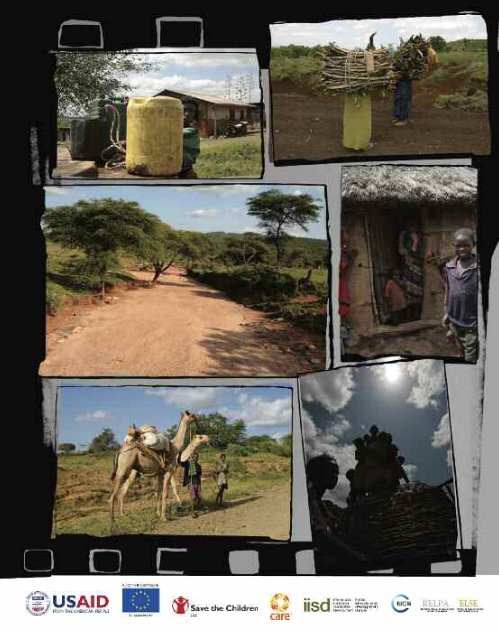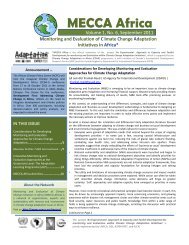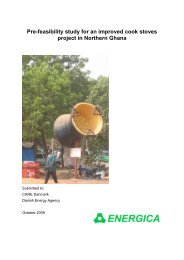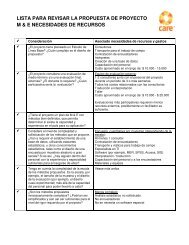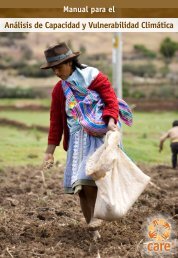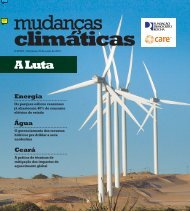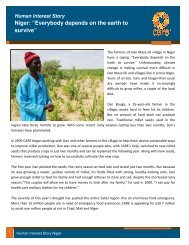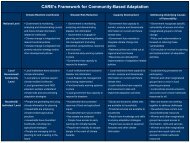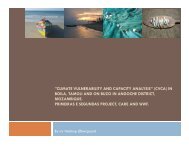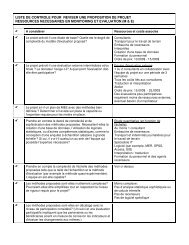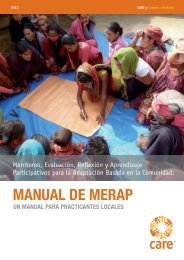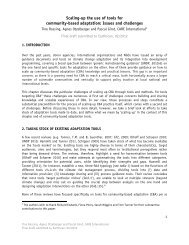Policy Brief - CARE Climate Change
Policy Brief - CARE Climate Change
Policy Brief - CARE Climate Change
Create successful ePaper yourself
Turn your PDF publications into a flip-book with our unique Google optimized e-Paper software.
The region’s climate is changing<br />
in unprecedented ways<br />
2<br />
Pastoral communities in the Borana and Shinile<br />
zones of Ethiopia have been adapting their<br />
livelihoods to changing environmental<br />
conditions for centuries. Recurrent droughts<br />
have been a major issue throughout history in the Ethiopian<br />
lowlands, and strategies to cope with, and adapt to these<br />
droughts are embedded in communities’ traditional social<br />
structures and resource management systems.<br />
However, communities and local governmental and<br />
non-governmental agencies are presently observing<br />
unp recedented climate variability and extremes.<br />
Scientific and community-based observations, collected<br />
by the International Institute for Sustainable<br />
Development (IISD), the International Union for<br />
Conservation of Nature (IUCN), <strong>CARE</strong> International<br />
and Save the Children UK (SCUK) during a 2009<br />
study in the Borana and Shinile zones of Ethiopia,<br />
show that the region’s climate is changing. Recent<br />
evidence includes increasing temperatures and drought<br />
frequency, as well as unpredictable rains that fall in<br />
shorter but more intense episodes. These trends are<br />
projected to continue over the next century.<br />
The magnitude and rate of current climate change,<br />
combined with additional environmental, social and political<br />
issues, are making many traditional coping strategies<br />
ineffective and/or unsustainable, amplifying environmental<br />
degradation and food insecurity, and forcing communities<br />
to rapidly find new livelihood strategies.<br />
The communities participating in this study have many<br />
ideas on how to prepare for future climate change,<br />
demonstrating a strong motivation to move out of<br />
poverty and take their future into their own hands.<br />
Suggested strategies include: modifying livestock diversity,<br />
composition and numbers; diversifying livelihood activities;<br />
producing, collecting and preserving hay; modifying<br />
rangeland management practices; modifying farming<br />
practices; maintaining, rehabilitating and constructing<br />
water infrastructure; education; savings and credit; establishing<br />
community groups to promote local<br />
engagement in a range of social and economic activities;<br />
making local natural resource management more<br />
effective, efficient and participatory; reducing conflicts<br />
over available resources; planting trees; and raising<br />
community awareness on climate change issues, including<br />
future projections and potential adaptation strategies.<br />
There are imporTanT<br />
barriers To adapTaTion<br />
ThaT The governmenT<br />
and civil socieTy can<br />
address<br />
Despite this sense of determination, pastoralists’<br />
ability to adapt is constrained by many factors including<br />
increasing land degradation; conflicts over scarce<br />
resources, which limit movement and destroy assets<br />
that are key for adaptation; limited access to<br />
information (including that on weather, climate change,<br />
markets, as well as pest and disease outbreaks);<br />
limited education, skills and access to financial services<br />
and markets required to diversity their livelihoods;<br />
inadequate govement policies, capacities and<br />
coordination; demographic pressures; and social and<br />
gender inequalities and marginalization, which reduce<br />
the voice and adaptive capacity of the most vulnerable.<br />
Enhancing the adaptive capacity of pastoralists in the<br />
<strong>Policy</strong> <strong>Brief</strong><br />
<strong>Climate</strong>-related vulnerability and adaptive-capacity in Ethiopia’s Borana and Somali communities
face of climate change will require community-based<br />
and community-led interventions, but will also require<br />
tailored support from NGOs, donors and governments.<br />
recommendaTions<br />
Based on the findings of this study, the research team<br />
has devised the following set of recommendations for<br />
three target groups: the Government of Ethiopia, civil<br />
society, and international donors.<br />
To The governmenT<br />
of eThiopia<br />
To counteract the adverse climate and poverty trends<br />
in pastoral areas, Ethiopia requires urgent changes in<br />
its rural and pastoral development priorities. The Government,<br />
operating at the national and sub-national<br />
levels, should aim to address the underlying drivers<br />
of climate-related vulnerability. This means implementing<br />
poverty reduction and development policies<br />
that: protect pastoral livelihoods and entitlements;<br />
enhance access to vital infrastructure, resources and<br />
services in pastoral areas; enhance the security of pastoralist<br />
land holdings; restore and protect the environment<br />
in rangelands; create more efficient markets<br />
and help control population growth, particularly through<br />
women’s education and empowerment. More specifically,<br />
the Government of Ethiopia should:<br />
1. Re-evaluate the place of pastoralism in Ethiopia’s sustainable<br />
development, protecting pastoral land from encroachment<br />
and conversion to unsustainable land uses.<br />
To be successful, customary and formal authority must<br />
find a basis for collaboration. Regional governments should<br />
should work to resolve internal boundary issues and<br />
engage with traditional social institutions in conflict prevention<br />
and resolution. In addition, policies should clarify<br />
land tenure systems that allow vital pastoral mobility, especially<br />
in the face of increasing drought frequency.<br />
2. Protect and enhance pastoral livelihoods through<br />
the development and implementation of appropriately-targeted<br />
economic development, social<br />
protection and relief strategies. Livestock marketing<br />
support and diversification activities, including adding<br />
value to livestock products such as milk, ghee, hides<br />
and horns, could contribute to increased pastoral<br />
incomes. The government should also support the<br />
improvement of social safety nets, while at the same<br />
time ensuring the availability and efficient distribution<br />
of emergency food aid and cash support.<br />
3. Improve coordination, communication and information-sharing<br />
between different government agencies<br />
from national to local levels, especially regarding<br />
weather, climate and food security information.<br />
Information pathways should be enhanced, so that<br />
local communities can access seasonal weather<br />
forecasts and early warnings for climate hazards as<br />
early as possible and in their own languages, and so<br />
that governments agencies can be promptly informed<br />
of poor rain conditions and food insecurity issues. In<br />
addition, government awareness of climate change<br />
impacts projections, and of the National Adaptation<br />
Programme of Action (NAPA) should be enhanced at<br />
all levels (from the national to the local level) to allow<br />
government officials to better deal with current climate<br />
risks and prepare for projected climate change.<br />
To civil socieTy<br />
To contribute to the enhancement of climate change<br />
resilience among pastoral and agro-pastoral communities<br />
in the Borana and Shinile zones, practitioners<br />
such as <strong>CARE</strong> and SCUK should take into account current<br />
climate variability, projected climate change impacts<br />
and climate change vulnerability and<br />
adaptation when developing programmes and projects.<br />
This should involve:<br />
3<br />
This policy brief is part of a research project entitled <strong>Climate</strong>-related vulnerability and adaptive-capacity in Ethiopia’s Borana and Somali communities
1. Creating partnerships<br />
with weather and climate<br />
institutions: this could include<br />
the National Meteorological<br />
Agency (NMA) of Ethiopia and<br />
the FEWS NET office in Ethiopia,<br />
as well as other regional climate<br />
analysis bodies such as the Intergovernmental<br />
Authority on Development (IGAD)<br />
<strong>Climate</strong> Predictions and Analysis Centre. These<br />
bodies could regularly provide useful local<br />
level data and information on expected<br />
seasonal weather conditions as well as medium<br />
to long term climate projections, as these<br />
continue to be generated and refined.<br />
Such data and information could be used<br />
to plan for and adjust programme interventions to<br />
ensure that the livelihoods and welfare of communities<br />
are safeguarded and improved in the face of current<br />
climate variability and change. For example, in view<br />
of the projected increase in heavy rainfall events,<br />
especially in Borana, practitioners could incorporate<br />
emergency and contingency planning and resources<br />
into the livelihood programmes in the area. This could<br />
take the form of construction of large cattle and<br />
human emergency shelters, as well as grain and seed<br />
banks that are raised above ground to reduce the<br />
negative impacts of flash floods. In<br />
addition, strategies could be put in<br />
place to prevent soil erosion by heavy rainfall<br />
events and reduce risks related to water-borne diseases.<br />
In view of the observed and projected decrease in<br />
the length of rainy seasons and increasing drought<br />
frequency, interventions could aim to improve food<br />
and fodder preservation; demarcation and management<br />
of dry season grazing areas and access to early maturing<br />
and drought tolerant crop varieties; as well as water<br />
harvesting, conservation and efficient utilization. As<br />
explained in greater detail below, strategies should<br />
be based on local vulnerability and knowledge, and<br />
should be community-led.<br />
2. Using traditional knowledge and starting from what<br />
people are already doing in their communites: Local<br />
communities are already observing and experiencing<br />
the effects of climate change, as well as implementing<br />
coping and adaptation strategies. Efforts to support<br />
climate change adaptation should be based on an understanding<br />
of what people are already doing in their<br />
communites, assessing the effectiveness of current<br />
coping strategies and how they might fare over the<br />
longer-term with climate change. Ineffective and unsustainable<br />
coping strategies are not always a choice;<br />
communities are often pushed into these strategies<br />
due to a lack of better options.<br />
4<br />
<strong>Policy</strong> <strong>Brief</strong><br />
<strong>Climate</strong>-related vulnerability and adaptive-capacity in Ethiopia’s Borana and Somali communities
Discussions with different community groups (women,<br />
men, older people, youth and children) can give insight<br />
into which community groups are vulnerable to what,<br />
and which coping strategies are implemented by<br />
different groups. Participatory community consultations<br />
should aim to develop sustainable alternatives to<br />
replace ineffective or unsustainable practices.<br />
3. Understanding climate-livelihood linkages in an<br />
intervention area: To ensure that development programmes<br />
and project activities promote climate change<br />
resilience and increase adaptive capacity, it is important<br />
to understand which livelihood resources are sensitive<br />
to climate hazards and which resources are important<br />
for adaptation. Development programmes and projects<br />
should aim to increase the availability of, access to, and<br />
control over resources that are key for adaptation.<br />
Tools have been developed to facilitate the analysis of<br />
climate-livelihood linkages and to improve the impact<br />
of interventions on community resilience, such as the<br />
<strong>Climate</strong> Vulnerability and Capacity Analysis (CVCA)<br />
Framework and the Community-based Risk Screening<br />
Tool – Adaptation and Livelihoods (CRiSTAL)<br />
(visit: www.careclimatechange.org/cvca.<br />
and www.cristaltool.org for more information).<br />
4. Building on community suggestions and recommendations:<br />
To ensure buy-in and make sure that adaptation<br />
strategies are community-led and based on local<br />
traditions and norms, adaptation strategies promoted<br />
by practitioners should build on suggestions and<br />
recommendations from communities. Strategies<br />
suggested by communities visited as part of this<br />
research are presented in the full assessment report,<br />
and include suggestions related to livestock diversity,<br />
composition and numbers, rangeland management<br />
practices, farming practices, alternative income<br />
generating activities, water ifrastructure, savings<br />
and credit, education, tree planting, social groups,<br />
local awareness raising and involvement of youth<br />
and women in decision making.<br />
5. Improving information and knowledge-sharing:<br />
Disagreements regarding suitable adaptation strategies<br />
have been observed within and between<br />
communities in Borana and Shinile. For<br />
example, communities seem to disagree<br />
on whether pastoralism or agro-pastoralism<br />
is better adapted to the new<br />
climatic conditions (especially increasing<br />
drought frequency). Many pure<br />
pastoral communities are gradually<br />
switching to agro-pastoralism<br />
as they believe it is more reliable<br />
than pure pastoralism, while many<br />
agro-pastoral communities want to drop out<br />
of agriculture. Bringing these two groups together, as<br />
well as different NGOs and governments who work<br />
with these communities, to share experiences on<br />
climate risks and different adaptation strategies, could<br />
prevent the implementation of adaptation strategies<br />
that have already been shown to be unsustainable in<br />
the long-run and favor collaborative development of<br />
new adaptation strategies.<br />
In addition, practitioners should aim to facilitate information<br />
sharing between weather and climate institutions (such<br />
as the NMA and FEWS NET) and local communities.<br />
Seasonal weather forecasts and early warnings for climate<br />
hazards should be available to local communities on<br />
time, and translated into local languages. In addition,<br />
communities should be supported in using climate<br />
information for planning.<br />
5<br />
This policy brief is part of a research project entitled <strong>Climate</strong>-related vulnerability and adaptive-capacity in Ethiopia’s Borana and Somali communities
6<br />
6. Addressing constraints to adaptation and building<br />
on enabling conditions: The main constraints and<br />
enabling conditions to the implementation of the<br />
different adaptation strategies suggested by communities<br />
in Borana and Shinile are presented in the full<br />
assessment report. The successful implementation of<br />
adaptation strategies will depend to a great extent<br />
on the ability of practitioners, communities and<br />
governments to address these constraints and build<br />
on existing enabling conditions. Not taking these key<br />
constraints into consideration risks undermining the<br />
success of the interventions. It could also inadvertently<br />
make communities even more vulnerable to climate<br />
risks. Addressing these constraints will require action<br />
from local to national levels.<br />
7. Addressing the underlying drivers of vulnerability:<br />
Key underlying drivers of vulnerability in pastoral and<br />
agro-pastoral communities in Borana and Shinile include<br />
environmental degradation; population pressures; conflicts;<br />
social and gender inequalities; inadequate off-farm<br />
employment opportunities and skills; poor access to<br />
infrastructure; resources and services; weakening of the<br />
role of traditional social and governance institutions and<br />
inadequate government policies; coordination and<br />
capacities. Practitioners should aim to address these<br />
underlying drivers of vulnerability.<br />
For example, interventions should aim to build resilient<br />
livelihoods by supporting investment in and development<br />
of key infrastructure and services. Construction of more<br />
schools (including mobile schools that are adapted to<br />
increased pastoral mobility), their appropriate staffing,<br />
and provision of incentives for school attendance such<br />
as food for education programmes could be beneficial.<br />
An increase in the number of human health care<br />
centres and services, including immunization<br />
and medical treatment, as well as training of<br />
community health workers, could help reduce<br />
impacts of diseases and mortality among<br />
vulnerable groups, thereby ensuring a<br />
strong, productive population that is<br />
less vulnerable to climatic shocks.<br />
Construction of veterinary centres and<br />
expansion of Community Animal Health Workers’ services,<br />
as well as regular supply of key veterinary medicines<br />
could help reduce livestock mortality from preventable<br />
and treatable diseases, and reduce livestock vulnerability<br />
during droughts and extreme heat events.<br />
In addition, practitioners should advocate for the<br />
improvement of market conditions (e.g. development<br />
of policies that support trade and increased revenue<br />
for the benefit of pastoralists, traders and public<br />
services). Direct support could be in the form of:<br />
construction of abattoirs at strategic points (e.g. market<br />
centres) in the region and training community members<br />
on hygienic slaughter, preservation and transportation<br />
of produce. They could be trained in, and provided<br />
with facilities for hygienic meat drying and packaging.<br />
Export markets for these products could be sought<br />
and cooperatives established and strengthened to<br />
maximize the benefits from such trade.<br />
Social and gender equality should be promoted in all<br />
interventions. In Borana, the impact of <strong>CARE</strong> interventions<br />
(such as the creation of and support to women groups)<br />
on women empowerment is already noticeable, with<br />
clear benefits on women’s adaptive capacity in the<br />
face of current climate hazards. However, important<br />
inequalities still remain, and women<br />
as well as youth empowerment<br />
activities should be scaled up<br />
nd replicated throughout<br />
pastoral areas.
To inTernaTional donors<br />
Donors should allow enough funding flexibility to<br />
enable practitioners to adjust interventions in the<br />
face of climate change uncertainties. In addition,<br />
donor funding should include funds for emergencies<br />
and contingencies to provide projects and programmes<br />
with adequate resources to address climate-related<br />
emergencies without threatening the achievement<br />
of programme/project goals and objectives.<br />
Donors should also promote<br />
the integration of climate<br />
change adaptation considerations<br />
into development<br />
programs, projects and<br />
policies. Comprehensive<br />
guidance on this is available<br />
through the OECD (2009).<br />
In addition, donor funding for adaptation to climate<br />
change should support all the four pillars of community<br />
based adaptation, namely: building resilient livelihoods,<br />
disaster risk reduction, capacity building and addressing<br />
the underlying causes of vulnerability (more information<br />
on these four pillars are provided in the <strong>CARE</strong> CVCA<br />
Handbook: www.careclimatechange.org/cvca).<br />
An integrated approach to reducing vulnerability<br />
would promote the achievement of positive<br />
programme/project outcomes and reduce the risks<br />
of maladaptation.<br />
7<br />
This policy brief is part of a research project entitled <strong>Climate</strong>-related vulnerability and adaptive-capacity in Ethiopia’s Borana and Somali communities
A<br />
HEAR<br />
OUR<br />
VOICES<br />
pastoralist woman’s<br />
quest to adapt to<br />
climate change.<br />
June 2009.<br />
“Some of the villagers decided to<br />
migrate further outside the<br />
usual territory while the rest of<br />
us returned to the village since<br />
the conditions were the same<br />
everywhere; we just had to find<br />
a way to live with the drought”<br />
Five years ago Ardo Musa and her<br />
husband owned several heads of<br />
cattle and 50 goats and sheep<br />
(shoats). Then tragedy struck, first<br />
she lost her husband to a<br />
mysterious disease leaving her<br />
alone to look after her seven<br />
children, and then drought hit her<br />
village, Kalabaydh, situated in Shinile<br />
District, twenty kilometers from<br />
Dire Dawa, Eastern Ethiopia.<br />
“Rain comes in two seasons here;<br />
we have what we call the Karan<br />
season when rain comes from July<br />
to September and the Dirac when<br />
we have the rains from March to<br />
May. If the rains fail in one season,<br />
they come in the next” explains the<br />
50 year old.<br />
But in 2007 there were no rains all<br />
through the year and drought hit<br />
Kalabaydh hard. The community<br />
decided to migrate to the highlands.<br />
“Walking to the highlands normally<br />
takes us ten days, this is difficult<br />
because we do it with children and<br />
the animals become weaker and<br />
weaker everyday” explains Ardo<br />
“sometimes we meet rustlers who<br />
take away our camels and cattle.”<br />
<strong>Policy</strong> <strong>Brief</strong><br />
<strong>Climate</strong>-related vulnerability and adaptive-capacity in Ethiopia’s Borana and Somali communities
A Collection of Testimonies on <strong>Climate</strong> <strong>Change</strong> from<br />
Pastoralists in Somali and Borana Zones of Ethiopia<br />
After losing 47 of her livestock and due to the fact<br />
that the highland area where they had migrated to<br />
was also now experiencing drought, Ardo decided to<br />
move back home.<br />
“Some of the villagers decided to migrate further<br />
outside the usual territory while the rest of us returned<br />
to the village because the conditions were the same<br />
everywhere, we just had to find a way to live with the<br />
drought” explains Ardo.<br />
According to Ardo some of those who decided to<br />
migrate outside the usual territory decided to leave<br />
their children with those who returned to the village so<br />
that they could get relief food and stay in school and in<br />
exchange they took the animals of those returning<br />
home to search for water and pasture.<br />
Adaptation<br />
The first thing Ardo did when she got home was<br />
to slaughter all the young animals that were<br />
suckling, this was a move to reduce stock with the<br />
hope that when the rains come, the more mature<br />
animals would produce more young ones and the<br />
herd would grow.<br />
Ardo also decided to focus on keeping hardy<br />
animals that could survive drought. “I started to<br />
gradually slaughter the sheep since they are<br />
weaker and remained with the goats since they<br />
can survive this hot weather” she adds.<br />
Currently Ardo and her community depend on relief<br />
food from the government. “Some of the villagers<br />
share their relief food with the pregnant and<br />
lactating animals. I don’t because I decided to get<br />
rid of all the young and small animals”<br />
says Ardo.<br />
Ardo also says that her families<br />
eating habits have changed. “You<br />
know, as pastoralists we consider<br />
food to be<br />
milk and meat. But now have been<br />
forced to live on porridge and injera,<br />
and we only eat two meals a day, so<br />
our children also face the threat of<br />
malnutrition” explains Ardo.<br />
The community gets water from a nearby river, which<br />
is also slowly getting depleted. “If only someone would<br />
help us put up water well or pump, then our lives would<br />
be better” she says.<br />
As the temperatures become higher and higher,<br />
many pastoralists women in Kalabaydh have had to<br />
change their lifestyle. “I can't call myself a pastoralist<br />
anymore, not with only three goats left, the negative<br />
changes in the weather have brought negative<br />
changes in my life too and now I leave it all to Allah”<br />
Special points of interest about Kalabaydh<br />
Kalabaydh Community is situated in Shinile District,<br />
20 kilometres from Dire Dawa town, in the Somali<br />
Zone of Eastern Ethiopia. There are around 60<br />
households in this community the majority of<br />
whom are pastoralists (keeping mainly camels,<br />
cattle, goats and sheep).<br />
Since 2007 the area has experienced serious<br />
drought making the majority of the pastoralists<br />
migrate outside their usual territory; some are<br />
said to have moved as far as the neighboring<br />
countries (Djibouti and Somaliland).<br />
Those who decided not to migrate further resorted<br />
to different adaptation strategies like slaughtering<br />
young animals, keeping animals like camels and<br />
goats that are more hardy and can survive drought<br />
and sometimes even sharing their relief food with<br />
their animals.<br />
Those that migrate continue to face conflict with<br />
other communities, insecurity and attacks from<br />
wild animals and having to walk for days with their<br />
children looking for pasture and water.<br />
9<br />
This policy brief is part of a research project entitled <strong>Climate</strong>-related vulnerability and adaptive-capacity in Ethiopia’s Borana and Somali communities
10<br />
T<br />
he<br />
i mpact of climate change on my<br />
family in her own words: June 2009.<br />
“My name is Quresha Farah, and I am 15 years old and the<br />
youngest in a family of 10 children. Currently I am in the<br />
seventh grade in a school that was constructed by<br />
Save the Children-UK here in Kalabaydh.<br />
My family are pastoralist and in the recent times because of<br />
the drought, life has been very difficult. When there is<br />
drought, my family has to go away to look for pasture and<br />
water for our livestock, whenever this happens, me and two<br />
of my younger siblings are left behind with relatives. I hate it<br />
when this happens because we get lonely and sometimes<br />
my family goes away for a long time.<br />
Currently my family is away, they have been gone for a month,<br />
and I have no idea when I will see them again. The last time<br />
they migrated, they stayed away for almost a year. I miss my<br />
family a lot, when we are together, I feel much happier.<br />
Quresha Farah: “The first thing I do when I get up in the<br />
morning is to prepare breakfast then run off to school. When I<br />
get back, I have to look for firewood and pasture for the young<br />
goats and sheep. Unlike before, these days I have to walk long<br />
distance to get leaves from short tress for the animals and<br />
also look for firewood.<br />
We also have a problem of food. When we have the rains we<br />
eat meat and drink plenty of milk. But now all we get is boiled<br />
black tea and injera, (pancake made from flour of a cereal<br />
known as teff) and we only eat in the morning and evening.<br />
We don’t take lunch anymore.<br />
Life as a pastoralist is very hard and I don’t want that for my<br />
future. That’s why I work hard at school. When I grow up<br />
I want to be a doctor and I hope to make a difference in my<br />
community.<br />
Most pastoralist women either don’t attend school ever or<br />
drop out when its time to get married. I don’t want to get<br />
married at the moment, I want to be different and get an<br />
education so that I can make my life better. I am lucky that<br />
my family encourages me in my education.<br />
At the moment I am praying for my family’s safety wherever<br />
they are. I don’t know when they will come back, maybe in<br />
the next month when it starts raining, maybe after many<br />
years, it's up to Allah.”<br />
<strong>Policy</strong> <strong>Brief</strong><br />
<strong>Climate</strong>-related vulnerability and adaptive-capacity in Ethiopia’s Borana and Somali communities
D<br />
ifficulties<br />
of migration in the<br />
present times: the story of<br />
Zahra Roble In her own words:<br />
June 2009.<br />
Over the years the climate has turned out to<br />
be really unpredictable. In 2006, we had<br />
good rains and we labeled it the year of<br />
marriage, because things were good, many<br />
people married, then came 2008 and we<br />
had bad drought, we called it the year of<br />
Yurara, meaning desperation.<br />
“I have given up; I will not migrate again,<br />
because it’s the same everywhere. It’s all<br />
dry and there is no water or pasture. My<br />
name is Zahra Roble. I am 30 years old<br />
and used to be a pastoralist woman. The<br />
sheep and goats were 300 in number, and<br />
there were 20 cattle and 5 camels. We<br />
have only 4 camels now after we lost all<br />
cattle and sheep and goats. Since there is<br />
not any pasture on which to graze, they<br />
have died of hunger and affected by many<br />
diseases related to the drought. The he<br />
exception is the camel, which has drought<br />
resistance capacity and is sustained by<br />
grazing the trees called garas<br />
During the drought time in 2008, my<br />
family decided to migrate. My husband<br />
went away with the big livestock; these<br />
are cattle and camels, while I took<br />
charge of our 10 children and smaller<br />
animals like and sheep.<br />
At this time I was pregnant, and it was the<br />
most difficult period ofmy life. I took care of<br />
my children, my animals and myself. I lost<br />
several of the animals to wild animal attacks.<br />
This year the Dirac rains that come from<br />
March to May failed and so we have started<br />
experiencing drought. The temperatures<br />
seem to be getting higher and higher<br />
everyday so I doubt if the Karan rains from<br />
July to September will be any better. The<br />
whole village is scared that this season, the<br />
drought might be worse than last years.<br />
At the moment we don’t plan to migrate,<br />
because it’s dry everywhere, unless we decide<br />
to move outside our normal territory, meaning<br />
moving out of the country to Somalia or<br />
Djibouti which would be really hard.<br />
With the changes in climate, we have had to<br />
change our lifestyle including how we eat.<br />
I can no longer afford milk and meat. Now<br />
I feed my children on Injera and black tea.<br />
I just hope that they don’t become<br />
malnourished before the rains.<br />
Because of the situation, we became<br />
agropastoralists and started farming. In the<br />
first year, we were beginners and we didn’t<br />
know how to cultivate. From 2008, we are<br />
becoming better than we were. But those<br />
who have livestock are getting worse and<br />
worse. If we harvest from our farm, then we<br />
may recover from the drought.”<br />
11<br />
This policy brief is part of a research project entitled <strong>Climate</strong>-related vulnerability and adaptive-capacity in Ethiopia’s Borana and Somali communities
C<br />
hanging<br />
lifestyle to survive the<br />
changes in weather:<br />
June 2009.<br />
“Because of the shortage of water, we get only a little<br />
sorghum. If there is no rain, we get nothing. This year,<br />
it wasn’t growing at the beginning. But now we have<br />
recultivated and there is a little growing. If it rains, we<br />
get something. If not, we have nothing to help us.”<br />
When Omar Jibril, lost more than 100 livestock in a span<br />
of three years to drought, he decided it was time to<br />
change his lifestyle. “After losing my livestock, I had to<br />
find a way to survive, so I decided to try my hand at<br />
agriculture” explains Jibril.<br />
The 58 year old resorted to farming for two reasons,<br />
he would have little to lose if the rains failed compared<br />
to what he would if he continued as a pastoralist and he<br />
also wanted to send his seven children to school.<br />
“Education is very important for me, and since Save the<br />
Children (SCUK) built for us a school, I want my<br />
children to be educated and not have to suffer<br />
like me” says Jibril.<br />
Jibril lives in Kalabaydh community in Shinile district,<br />
twenty kilometers from the famous town of Dire Dawa<br />
situated in Eastern Ethiopia. It is a Somali community of<br />
mainly pastoralist with a few<br />
people taking up agriculture<br />
a means to cope with the<br />
drought. He currently has 2<br />
cows and 20 shoats (sheep<br />
and goat).<br />
I planted failed” adds Jibril “so now my only option is to<br />
sell charcoal and firewood.”<br />
Asked about the future, Jibril is very pessimistic, “why<br />
ask about the future when the present is already bad<br />
enough, there might be no future” laments Jibril.<br />
He adds that the Government needs to come to the<br />
rescue of pastoralists in Somali region. “There is ground<br />
water that can be tapped in this area, the government<br />
needs to come to our aid” He concludes.<br />
Kalabaydh’s elders take on climate change<br />
The elders of this community agree that the<br />
temperatures have been increasing especially in the<br />
last three years. With 2009 being the hottest so far.<br />
They also sighted the outbreaks of strange animal<br />
diseases like Sung Sung, a disease that causes<br />
severe bleeding through the nose and<br />
miscarriages in cattle.<br />
The main economic activity for the community at the<br />
moment seems to be charcoal production and<br />
selling of firewood. However they have to walk very<br />
long distances to source the wood. If the dry season<br />
continues, there is a likelihood that most of the<br />
community members will move to the nearby town<br />
known as Dire Dawa and to neighboring countries.<br />
13<br />
Persistent drought and high<br />
temperatures in the village<br />
has affected agriculture, and<br />
it is no longer a viable<br />
solution making many of the<br />
pastoralists resort to<br />
charcoal production and<br />
selling of firewood.<br />
“I am not sure if farming is a<br />
good idea anymore, the<br />
drought seems to be<br />
worsening and the last three<br />
years have been worse, all<br />
the maize and sorghum that<br />
This policy brief is part of a research project entitled <strong>Climate</strong>-related vulnerability and adaptive-capacity in Ethiopia’s Borana and Somali communities
14<br />
T<br />
he<br />
struggle of an agro-pastoralist with<br />
<strong>Climate</strong> <strong>Change</strong>: June 2009<br />
“We are scared that the Hagaya rains might also fail<br />
like the Gana rains and if that happens we will surely<br />
suffer. Hunger is knocking on our doors.”<br />
Dida Dabasa and his family have always depended on<br />
agriculture. But in the last three years, things have turned<br />
out different. “Since 2005 the rains have been erratic,<br />
when they come, they are too much and they destroy our<br />
crops” laments the 80 year old.<br />
Dabasa lives in the Billa, a village in Teltele District of the<br />
Borana Zone in Southern Ethiopia. It is an agro-pastoralists<br />
community that mainly grows maize, sorghum and teff<br />
(a type of a cereal used to make the Ethiopian pancake<br />
known as Injera).<br />
The area experiences two rainy seasons, the Gana, where<br />
rains come between March and May and the Hagaya<br />
when rain comes from September to November. However<br />
in the last three years, Billa has experienced erratic<br />
weather patterns.<br />
“In 2005 we have violent rains that destroyed most of our<br />
crops and we had very little yields, and food was a real<br />
problem” explains Dabasa, “then in 2006 we had the<br />
major drought.”<br />
Drought was not the only worry for the Billa community, in<br />
2008, most of the community members were displaced as a<br />
result of land conflict with a neighboring tribe known as the<br />
Konso over land.<br />
“This conflict was as a result of farmland between us and<br />
people from the Konso tribe, who have been encroaching on<br />
the Borana land for a long time now, many people were killed<br />
<strong>Policy</strong> <strong>Brief</strong><br />
<strong>Climate</strong>-related vulnerability and adaptive-capacity in Ethiopia’s Borana and Somali communities
and the rest of us displaced” he adds<br />
“to make matters worse they burnt<br />
all the crops we had harvested<br />
in the past year so we have had no<br />
food reserves.”<br />
In 2009, the whole Borana zone received very little<br />
rains during the Gana season. “The rains came in May<br />
and only for 11 days. These were light rains so<br />
definitely our crops failed yet again” laments Dabasa.<br />
Although they are readying themselves for the Hagaya<br />
rains, members of the Billa communities are skeptical<br />
“We are scared that the Hagaya rains might also fail<br />
like the Gana rains and if that happens we will surely<br />
suffer. Hunger is knocking on our door.” says Dabasa.<br />
To survive, Dabassa and his wife have now resorted to<br />
selling firewood and wood for construction of houses.<br />
But this alternative is proving very challenging for the<br />
old couple “currently everyone is selling wood and so the<br />
prices are down” says Dabasa.<br />
Although he keeps some goats and sheep, he knows that<br />
he might eventually have to sell them to get some food<br />
for his family. “We have already<br />
started experiencing food<br />
insecurity in our village”<br />
Although Dabasa has never heard of<br />
the term climate change or global<br />
warming, he knows that something<br />
has changed with the climate and he<br />
has his own explanations for it.<br />
“The rains don’t come as expected anymore and the<br />
temperatures are higher, God is displeased with us and he<br />
is punishing us for being careless with each other and his<br />
creation, it is time for us to change” concludes Dabassa.<br />
Points of interest about Billa<br />
Billa has over 350 households.<br />
The area experiences two rainy seasons known as<br />
Gana and Hagaya. Gana comes from March to May<br />
and Hagaya is from September to November<br />
The community is agro-pastoralist growing mainly<br />
maize, teff , sorghum and bean while rearing mainly<br />
sheep and goats.<br />
Conflict: In 2008 there were ethnic skirmishes<br />
between the Boranas of Billa and their neighbors<br />
who come from the Konso tribe. Many people were<br />
displaced, some were killed, and crops were burnt.<br />
Drought: In 2006, there was a big drought<br />
in the area.<br />
15<br />
This policy brief is part of a research project entitled <strong>Climate</strong>-related vulnerability and adaptive-capacity in Ethiopia’s Borana and Somali communities
16<br />
S<br />
urviving<br />
<strong>Climate</strong> change.<br />
June 2009.<br />
“Previously drought came after every 8 years and<br />
it was something we knew and prepared for, but<br />
now the drought season is long and is here<br />
almost every year”<br />
Karu Ardi, 45, has been a pastoralist all her life, and<br />
during drought season she normally migrates with all<br />
her six children to look for pasture and water for her<br />
animals.<br />
“For me migrating is normally the best option when<br />
there is drought, I just pack up my family and leave”<br />
says Ardi.<br />
Last year during the drought season Ardi and her<br />
family migrated to Moyale, the town that borders<br />
Kenya, 100 kilometers away from her current home<br />
and came back home relieved after the onset of the<br />
rains. But the relief was short-lived.<br />
“It rained heavily but for only two days and therefore<br />
there has not been enough pasture, we now feed our<br />
animals on tree leaves to supplement the little<br />
pasture” adds Ardi.<br />
Migration is not an easy process for most pastoralist<br />
women as they have to part with their husbands who<br />
move away with the bigger animals like camel and<br />
livestock. “We walk for long distances with our<br />
children and live in makeshift houses that do not<br />
shade us very well from harsh weather conditions<br />
hence we are prone to sickness” says Ardi.<br />
<strong>Policy</strong> <strong>Brief</strong><br />
<strong>Climate</strong>-related vulnerability and adaptive-capacity in Ethiopia’s Borana and Somali communities
Sometimes these women also<br />
face attacks from wild animals and in the recent<br />
times attacks from bandits and livestock rustlers.<br />
Ardi and her community are hoping that the Hagaya<br />
rains from September to November will be better<br />
though the climate of the area has truly changed and<br />
drought is now more frequent.<br />
“Previously drought came after every 8 years and it<br />
was something we knew and prepared for, but now the<br />
drought season is long and is here almost every year”<br />
In 2008 when drought hit Jaso Dima village, she<br />
and her family lost two camels and five cows,<br />
a considerable loss for any pastoralist.<br />
For the time being Ardi and her husband are selling<br />
salt to survive as they prepare for the rainy season.<br />
They used to sell firewood but not anymore. “The<br />
government has put some restriction on selling<br />
firewood here at the moment, so to get some little<br />
money we sell salt from the nearby crater to get<br />
money to buy cereals to feed ourselves and the young<br />
animals” she says.<br />
But if the rains don’t come, Ardi and her family will be<br />
on the road again, to look for pasture and water for<br />
their precious animals. “We have no options, these<br />
animals are our lives and so despite the difficulties if<br />
the rains don’t come we will migrate” says Ardi<br />
Although climate change and global warming are<br />
words that Ardi has never heard of before, she knows<br />
for sure that there is a difference in the climate and<br />
times are getting hard. “The temperatures seem to<br />
be rising and the rains are becoming less<br />
with every season” she says “God must be<br />
displeased with us."<br />
17<br />
This policy brief is part of a research project entitled <strong>Climate</strong>-related vulnerability and adaptive-capacity in Ethiopia’s Borana and Somali communities
Gababa is a mason’s assistant in Dubluk,<br />
a town situated in the Borana Zone of<br />
southern Ethiopia. “In a day I make about<br />
13 Birr (one US dollar) and this is enough<br />
for our survival” says Gababa.<br />
According to Gababa, the life of a pastoralist<br />
has become much harder. “Rainfall has<br />
decreased and the temperatures continue<br />
to rise everyday, it is just too difficult to be a<br />
pastoralist in these times” He explains<br />
Gababa also adds that population pressure<br />
has made it hard to migrate. “Because of<br />
population pressure, pasture land has<br />
become limited and it is no longer easy to<br />
just settle in any piece of land and graze<br />
your animals, if you do this you are likely to<br />
be attacked by land owners” he says.<br />
In general Gababa believes that a<br />
pastoralist life has become even harder<br />
and it is no longer viable.<br />
“Walking for long distances looking for<br />
water and pasture has also become<br />
dangerous. You can be attacked by wild<br />
animals and also cattle rustlers and there<br />
are also chances that you might not even<br />
get the pasture because of the changing<br />
weather conditions” explains Gababa.<br />
For Gababa, it is time for pastoralists to be<br />
open-minded and realize that changes in<br />
climate calls for changes in lifestyles.<br />
<strong>Change</strong>s in <strong>Climate</strong> made me drop out from<br />
pastoralism. June 2009.<br />
“Look at me, because I accepted my<br />
circumstances, am now able to feed my<br />
family and am still alive even though am not<br />
a pastoralist” he adds “had I continued with<br />
pastoralism I would have nothing.”<br />
“Rainfall has decreased and the temperatures continue to rise<br />
everyday, it is just too difficult to be a pastoralist in these times”<br />
After losing his livestock to drought several times, Dalo Gababa, 36, decided<br />
to drop out of pastoralism and look for casual labor in the urban centre. “<br />
“At first I just had no alternative, I had lost over 80 livestock, I had to get a<br />
means of survival, so I decided to move to the urban centre and look for<br />
casual labor” says Gababa.<br />
<strong>Policy</strong> <strong>Brief</strong><br />
<strong>Climate</strong>-related vulnerability and adaptive-capacity in Ethiopia’s Borana and Somali communities
This policy brief is part of a research<br />
project entitled <strong>Climate</strong>-related<br />
vulnerability and adaptive-capacity in<br />
Ethiopia’s Borana and Somali<br />
communities. The International Institute<br />
for Sustainable Development (IISD) was<br />
contracted by <strong>CARE</strong> International and<br />
Save the Children UK (SCUK) to lead this<br />
study. Technical support was provided<br />
by the International Union for<br />
Conservation of Nature (IUCN), <strong>CARE</strong><br />
International, and SCUK. Financial<br />
support was provided by the United<br />
States Agency for International<br />
Development (USAID) and the European<br />
Commission Humanitarian Aid<br />
Organization (ECHO).<br />
The process of undertaking this research<br />
involved a combination of training<br />
activities, field visits, and stakeholder<br />
consultations, which were conducted in<br />
Ethiopia during May and June of 2009.<br />
The full research report is available at/<br />
from:<br />
www.savethechildren.org.uk<br />
www.careclimatechange.<br />
org/files/reports/ethiopia_<br />
pastoralists_report2009.pdf<br />
www.elmt-relpa.org/aesito/elmt<br />
August, 2009<br />
Authors: Béatrice Riché (IISD), Anne Hammill (IISD), Editors: Tamara Plush<br />
(<strong>CARE</strong> International), Demeke Eshetu (SCUK), Testimonies: Linda Ogwell<br />
Photography/Design: Sylwia Pecio<br />
19<br />
Save the Children UK and <strong>CARE</strong> International grant permission to all<br />
not-for-profit organizations to reproduce this work, in whole or in part.<br />
The following notice shall appear conspicuously within any whole or<br />
partial reproduction: “<strong>Climate</strong>-related vulnerability and adaptivecapacity<br />
in Ethiopia’s Borana and Somali communities” © by 2009<br />
Save the Children UK and <strong>CARE</strong> International. Used by permission.<br />
This policy brief is part of a research project entitled <strong>Climate</strong>-related vulnerability and adaptive-capacity in Ethiopia’s Borana and Somali communities


